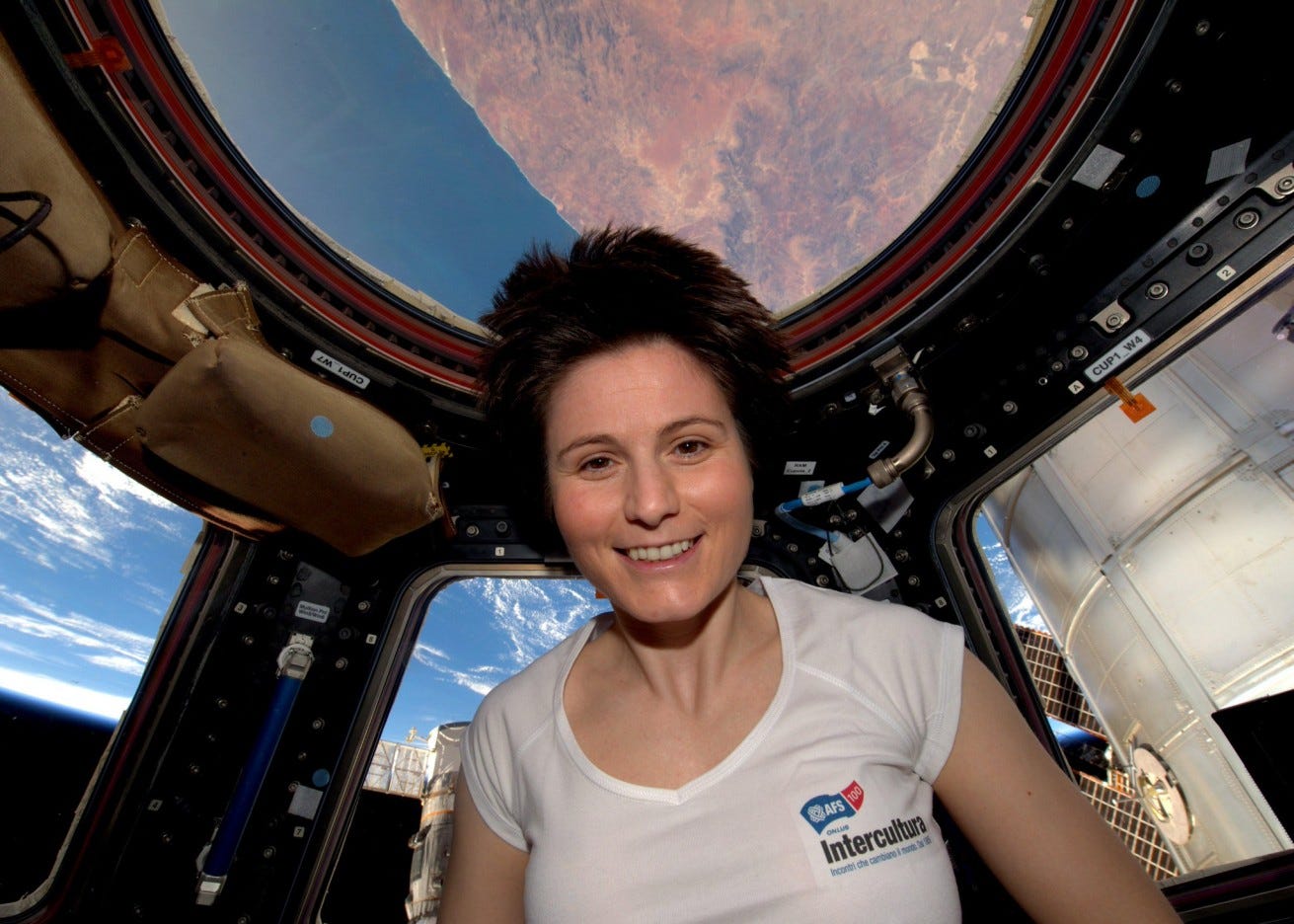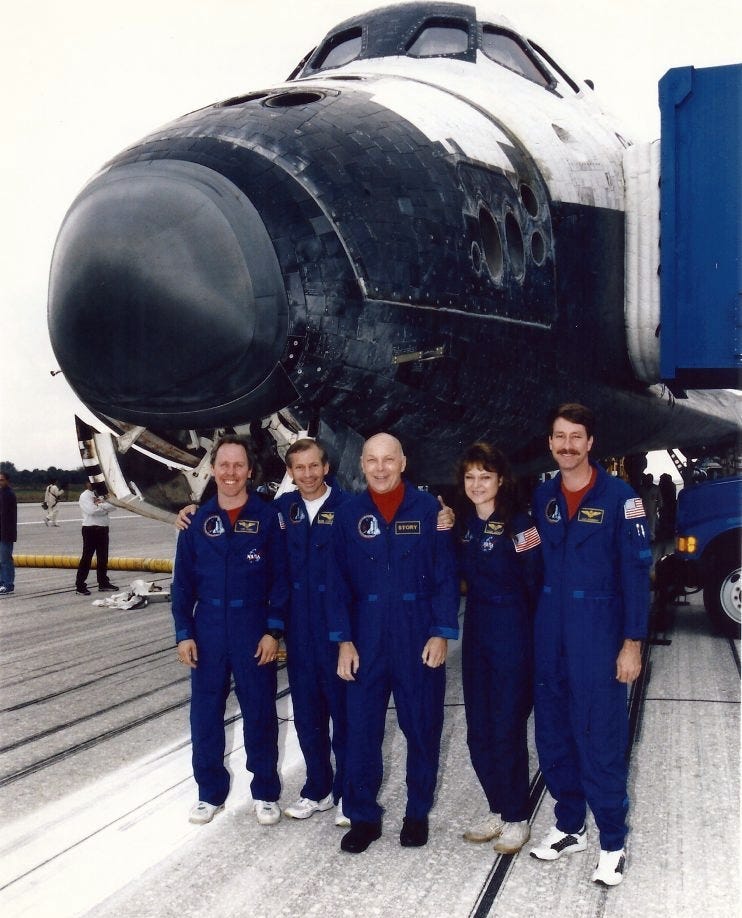The Right Stuff Never Stumbles
How can American astronauts walk after being in space two weeks and Russian cosmoneaughts can't?
All images in this article courtesy of NASA.
“The most miraculous thing was when they could get out of the spacecraft and not flop on their faces; and they could go up into the helicopter and get out on the carrier deck and walk pretty well. They were in better physiologic shape than the V crew. Initially, their tilt-table responses were not as bad and did not last as long. It looked more like four-day responses, by far, than eight-day. The calcium loss was the same way. Amazingly, they maintained their total blood volume. They didn't get any decrease, but they did it in a peculiar way. They lost the red-cell mass still, but they replaced the plasma-they put more fluid in. Apparently, there had been enough time for an adaptive phenomenon to take place.”
On The Shoulders Of Titans, p. 294
From Sea Legs To Space Legs
The effects of weightlessness on the human body are well documented such as muscle degradation, calcium loss and other physical irregularities. The problems do not end there. Astronauts once returned to earth and gravity have a difficult time getting readjusted to having weight and mass and spatial orientation. They can have trouble talking and have blood pressure issues. Even the immune system can be compromised causing an astronaut to battle a minor infection. In many ways it is similar to sailors getting their “sea legs” once back on land after being months at sea.
Basically, weightlessness messes with your body. The bowstring is no longer taut.
As astronaut Samantha Cristoforetti said after her 200 days in space, “Your coordination, your balance, all the little tiny muscles that you don’t even know you have but that help you to sit upright and walk upright”—all that was gone.” This required her to experience weeks of rehabilitation after returning from space. Walking was so difficult that Cristoforetti remarked that her legs felt like “tree trunks.”
Shuttle astronaut Dr. Anna Fisher remarked, “Also in your sensory canals there is a mismatch between what you’re feeling and seeing so it take a while to adapt not only to get your space legs when you come back you find you are actually walking down the hall at an angle because you have to recalibrate to not moving all over the place.”
These astronauts are examples of how prolonged space travel affects them physically and the hard work required to get back to normal physical health.
Space Tourists
And lastly, space tourists. So far the list is Dennis Tito, Mark Shuttleworth, Gregory Olsen, Anousheh Ansari, Rick Tumlinson and Guy Laliberté. None of them can walk or remove themselves from the capsule after landing without help. Once removed they are placed in chairs and then toted off the landing field. They are never seen walking away. Most space tourists spend around 10 to 12 days on the ISS. That seems to be enough time to stop their ability to move independently and orient themselves upon landing and returning to normal life.
Iranian-American engineer Anousheh Ansari had a blog (since removed) about her stay on the ISS in 2006. She describes the sensation of reentering gravity after being weightless for 11 days. She needed help getting out of the capsule, needed assistance getting off the landing field and needed help getting out of her space suit. She could not walk at first and felt extremely heavy, the end result of not using muscles which normally endure resistance against gravity. Her experience illustrates that it does not take long for one to lose the ability to walk after being in space. She recovered soon after.
Medical Effects of Spaceflight by Elizabeth Gibney
In this article by Elizabeth Gibney (linked below) she lists the effects on the body in zero G space environments. Here are just a few:
“Adaptation of the heart and the cardiovascular system to microgravity is rapid and effective. The adaptation is primarily a general response to a headward shift of body fluids. The concentration of red blood cells (or RBCs) stays about the same, surprisingly, even though plasma volume decreases in space.
As humans are exposed to the microgravity of space, there is a loss of fluid. This suggests that the concentration of RBCs should increase. However, this does not happen. Thus, the concentration of RBCs must be somehow decreasing.
This reduction of RBCs is known as "space anemia". This happens through negative feedback. As the concentration of fluid decreases, the kidney reduces the production of erythroprotein which in turn suppresses RBC formation. Thus the concentration of RBCs is maintained in the blood preventing any extremities.
Human muscles adapt to new situations. When we need our muscles, we can activate them almost immediately. When a person does not use his muscles for a period of time, the muscles begin to waste away or "atrophy". Astronauts, while in space do not require the use of their "anti-gravity" muscles and thus experience this natural atrophy.
When astronauts return to earth, these muscles can still cause problems. Thus, in microgravity, tension is reduced on muscles that support the body against gravity, resulting in a loss of muscle mass and an accompanying loss of muscle strength.
The main problem to be faced is that exposure to microgravity causes a reduction in the endurance capacity of skeletal muscle. A reduction in bone marrow also results due to the absence of gravitational force. In certain parts of the body (like the legs) this loss can amount to 1.5% per month, thus resulting in an unacceptable loss for a mission that takes approximately 2.5 years.”
The Enigma Of the Gemini 7 Mission
The leading quote at top of this page is from page 294 of On The Shoulders Of Titans by Barton C. Hacker and James M. Grimwood. The physical effects of returning to earth from space were well known to NASA early on.
Gemini 7, launched in December of 1965 lasted for 13 days to test the effects on human beings in a weightless environment. For astronauts Col. Frank Borman and Capt. James A. Lovell Jr., exiting their space capsule with no help and walking on the deck of the carrier the USS Wasp after stepping off the rescue helicopter. The authors referred to it as a “miraculous thing” that they didn’t stumble and fall on their faces. And finally ending with the quote, “Apparently, there had been enough time for an adaptive phenomenon to take place.”
What kind of adaptive phenomenon would that have been? Seems like they are grasping for straws. They have no answer for how these two men who spent two weeks in weightlessness, with no exercise, immediately upon landing could walk without a fuss. Clearly, the adaptive phenomenon is not at work now. Astronauts, cosmonauts and space tourists are incapacitated from walking upon landing. The alleged miracle is hung in the air, will never be officially answered, and it will remain as it is, a mystery.
Russian Cosmonauts Can’t Walk After Landing
This is not the same situation with Russian Cosmonauts. In 1970 Col. Andrian G. Nikolayev and Vitaly I. Sevast in Soyuz 9 spent 18-days in space beating Gemini 7’s record. They needed help leaving their capsule and had to be carted off the landing field and had afterward had trouble walking.
From Wikipedia:
“The spacecraft soft landed in the steppes of Kazakhstan, and the crew was picked up immediately. Adjusting to gravity of Earth seemed to present a minor problem for the two cosmonauts. They required help exiting the descent module and were virtually unable to walk for a few days. Nonetheless, this experience proved the importance of providing crews with exercise equipment during missions. After landing the crew spent 2 weeks in a quarantine unit originally designed for cosmonauts returning from Moon landings. At the time the Soviet press reported that this was done to protect the cosmonauts in case space travel had weakened their immune systems.”
Also, from Aulis.com:
“The Soyuz 9 cosmonauts returned to Earth in a pre-infarction state (decreased blood supply to the heart muscle). They could not get up for more than six days. (Thereafter Soviet cosmonauts didn’t fly in any spacecraft for more than eight days).”
As shown above, the space tourists also needed help getting out of the space capsule as Russian cosmonauts did and like them, could not walk afterward. In fact, no astronauts from the missions of the Gemini or Apollo had these issue either.
This seems to be only the problem of Russian Cosmonauts and space tourists. Why? Could it be that none of these missions actually happened?
In Closing
I am disappointed to conclude that it appears that the Gemini and Apollo Astronauts were not in space as long as has been officially reported. The effects of zero G (microgravity) are well documented and known for over 50 years. The idea that these astronauts, especially the Gemini and Apollo crews, showed no evidence of physical problems previously mentioned is quite odd. They should have had issues, especially with motor skills and inability to walk or get out of the capsule on their own. In 2022 SpaceX astronauts when recovered from splashdown were taken away on carts. But in the NASA years of the space race, we see these men returning from space without as much as a hitch in their giddyup. This is the closest thing I have seen regarding fraud in the United States space program.
Endnotes
Gemini 7 was launched in 1965 and at the time was the longest NASA space orbital mission lasting 13 days.
On The Shoulders Of Titans is an in-house NASA publication documenting the history of the Gemini program.
At the time of her interview, astronaut Samantha Cristoforetti set the 200 day record for the longest period in space for a European woman astronaut. Record broken in 2017 by Peggy Whitson.
Zero Gravity and Microgravity are interchangeable. It appears that zero-G has fallen out of favor.
Apollo 11 astronauts Neal Armstrong and Edwin “Buzz” Aldrin spent 6 days in space before landing. Did the 1/6 gravity help them with walking on the moon? Micheal Collins did not land but was in space for a total of 10 days. He had no issues leaving the spacecraft for rescue or walking afterward. But the space tourists spending 10 days in space do.
If it takes a year to travel to Mars, how are the astronauts going to walk when they get there? They would need an artificial gravity system for the trip. Is that in development?
5.29.24
STS-80 crew in 1996 shortly after landing. They allegedly spent 17 days in orbit. Unlike Russian cosmonauts they had no trouble walking after landing at the Kennedy Space Center.
Sources
On The Shoulders Of Titans by Barton C. Hacker and James M. Grimwood. Available free as a PDF from nasa.gov. Kindle and paperback versions are available on Amazon.
https://history.nasa.gov/SP-4203.pdf
Medical Effects of Spaceflight
https://www.aulis.com/medical.htm
Astronaut Samantha Cristoforetti
https://www.telegraph.co.uk/women/11708381/Record-breaking-astronaut-Samantha-Cristoforetti.html
Dr. Anna Fisher
Russian cosmonauts not being able to walk after landing.
https://www.aulis.com/apollo-soyuz13.htm
https://en.wikipedia.org/wiki/Soyuz_9
STS-80 Space Shuttle mission 1996
https://en.wikipedia.org/wiki/STS-80
Space Tourism
https://en.wikipedia.org/wiki/Space_tourism







